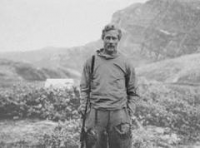Count Eigil Knuth
Contents
[hide]Country
Denmark
Birth - Death
1903 - 1996
Occupation
Explorer
Notable Achievements
Knight of the Danneborg
Description
Eigil Knuth was one of the great explorers of the mid-twentieth century who is especially notable for his travels, explorations, and writings of the emerging area of Greenland. His interest in exploring derived from a family rich in a tradition of travel and exploration – his grandfather, in particular, is noted for having financed the first person to traverse the Greenland icecap. Knuth has been called the ‘last great Arctic explorer in the classic mould’.
It is interesting that Knuth’s education and early career was in the arts and sports fields. He was a noted art critic at a Copenhagen newspaper after a period of training as a sculptor in Italy in his youth. Later in life there developed a high regard for his sculptor work, which was often in the native styles he discovered during his explorations. While sculpting, he engaged part-time in various archeological expeditions, and this led to his eventual full-time attention.
The aim of much of Knuth’s exploration was the study of anthropology. He was particularly noted for the encouragement and awareness he created of Eskimo and other native art associated with the lands he explored. In particular, Knuth discovered two unknown prehistoric Eskimo cultures in Independence Fjord and Aaamarks Fjord. Both discoveries confirmed the areas were populated from migrations of North Americans.
Knuth’s exploration work lead to new information in geology, zoology, and botany. This work has lead to a materially higher degree of understanding of human life that lived under extreme conditions over the long term. His work provides unique evidence of the cultural history of the High Arctic.
Knuth is considered the last individual to explore the only remaining unknown areas on the planet. Thereafter, subsequent explorers filled in the blanks of their predecessors’ voyages and expeditions. The assent of the airplane and its use in exploration was a particular feature in advancing the global race to explore during Knuth’s time, and he participated eagerly in the frenzy of activity which included the Americans, the English, and the French.
Knuth was a prolific author of his travels, writing a total of twelve books on the subject of exploration. He was instantly memorialized in his book The Northernmost Ruins of the Globe (2003). This includes a summary of the 137 sites that Knuth explored and includes topographical and archeological information, site structure, artifact statistics, and radiocarbon dating analysis of the areas.
As mentioned, Knuth is also a noted artist. His sculptures, water colours, paintings, and ceramic work all reflect his experiences and love of the arctic and its rich history. His artwork is considered outstanding. His work was exhibited at the 1939 World’s Fair in New York.
Knuth was the co-founder of the Arctic Institute (Arktisk Institut), a place for the assembly and concentration of all research regarding Greenland. The Institute collects diaries, photographs, and other materials from the various explorations of the region. It remains a repository for their preservation and registration, engaging in communication and education projects about the north.
The honours Knuth received include the Hans Egede Medal of the Royal Danish Geographical Society, the Patron’s Medal of the Royal Geographical Society, the Mungo Park Medal of the Royal Scottish Geographical Society, and many more. He was made a Knight of the Danneborg, and also received the medal of that order, and the Danish Medal of Merit in silver.
Eigil Knuth was never particularly reticent and shy about his homosexuality. However, he privately regretted that he did not publicly declare his homosexuality at an earlier point in his career. He has been noted by his contemporaries for his simple lifestyle and his sense of humour. Knuth much preferred to live in a tent in the high north than anywhere else, and apparently he kept his tent in immaculate order and enjoyed serving his fellow companions multi-course meals. His kinship lay most closely with the Inuit hunters whose ruins he studied.
See Also
- LGBTQ Explorers and Adventurers
- LGBTQ Sculptors
- LGBTQ Individuals in the Fields of Sociology and Anthropology
- Art and Culture Critics Who Identify as LGBTQ
- Notable LGBTQ Participants in Mining, Minerals, Metallurgy, and Geology

